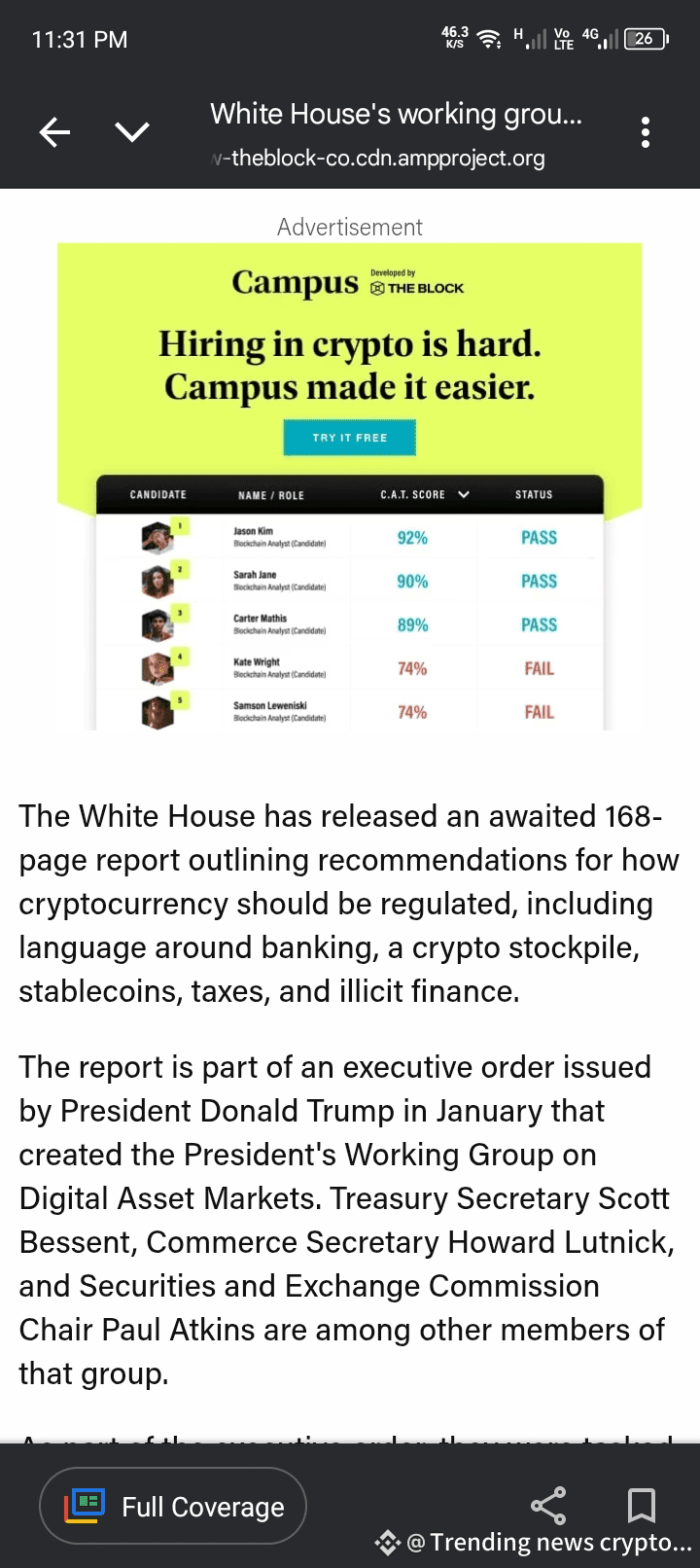In January, Trump tasked a crypto working group with laying out recommendations for a regulatory framework for digital assets, including stablecoins.
During a press briefing earlier in the day, senior administration officials said the report was likely the most comprehensive product that’s been released for digital assets.
The White House has released an awaited 168-page report outlining recommendations for how cryptocurrency should be regulated, including language around banking, a crypto stockpile, stablecoins, taxes, and illicit finance.
The report is part of an executive order issued by President Donald Trump in January that created the President's Working Group on Digital Asset Markets. Treasury Secretary Scott Bessent, Commerce Secretary Howard Lutnick, and Securities and Exchange Commission Chair Paul Atkins are among other members of that group.
As part of the executive order, they were tasked with submitting a report that laid out recommendations for a regulatory framework for digital assets, which one crypto industry lead said would serve as a "regulatory Bible" or guidebook for the sector. And the working group voiced support for the sector in its report on Wednesday.
"The Working Group, as the author of this report, endorses the notion that digital assets and blockchain technologies can revolutionize not just America’s financial system, but systems of ownership and governance economy-wide," they said in the report. "American entrepreneurs who pioneer new industries using these technologies deserve both clarity on the policies that affect their efforts and praise for the progress they have made."
During a press briefing earlier in the day, senior administration officials said the report was likely the most comprehensive product that's been released for digital assets.
The working group made several recommendations in the report, including urging Congress to affirm that people can custody their own crypto without a middleman in place, as well as granting the Commodity Futures Trading Commission authority to "regulate spot markets in non-security digital assets."
The President's Working Group was also tasked with assessing the creation of a digital asset stockpile.
Trump proposed creating a digital asset stockpile and a strategic bitcoin reserve in March via an executive order. At the time, Trump had tasked Lutnick and Bessent to develop budget-neutral strategies for acquiring additional bitcoin, provided that those strategies have no incremental costs to American taxpayers.
As for the stockpile, the executive order said it would not acquire additional assets for the stockpile beyond those obtained through forfeiture proceedings. Ahead of issuing the order, President Trump announced plans to move forward with a U.S. crypto strategic reserve that included XRP, SOL, and ADA alongside BTC and ETH.
In the report on Wednesday, the working group said both the reserve and stockpile would be administered by the Treasury Department and that they would "be capitalized by forfeited digital assets."
They also said the bitcoin in the reserve will, in general, not be sold and "will be maintained as reserve assets of the United States utilized to meet governmental objectives in accordance with applicable law."
There was not a lot of language around next steps for a bitcoin reserve in the report, but senior administration officials noted that that was part of a separate executive order issued by Trump. They also said that the Treasury Department's work on the bitcoin reserve is underway and that there will be more information on that soon.
The report comes just weeks after a bill to regulate stablecoins called Guiding and Establishing National Innovation for U.S. Stablecoins, or GENIUS, was signed into law by President Trump. The bill would create a federal regulatory framework for stablecoins, requiring stablecoins to be fully backed by U.S. dollars or similarly liquid assets, among other requirements.
The U.S. House of Representatives also passed a bill this month to regulate the crypto industry at large, but the Senate has since released its own version of the bill.
A fact sheet circulated earlier Wednesday with recommendations from the working group to usher in the "golden age of crypto." That fact sheet referenced the House's version of market structure, nicknamed Clarity, several times.
Senior administration officials noted that Clarity received a bipartisan vote and said they would see how it plays out over the next few months.
The fact sheet also included language around crypto taxes, which had been a priority for some in the industry.



